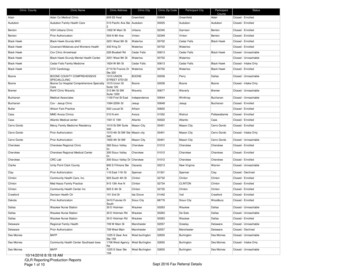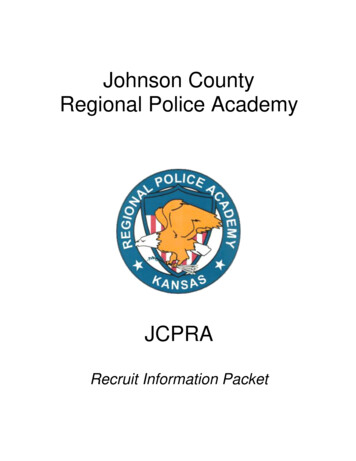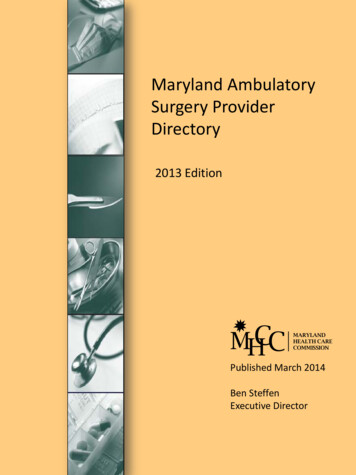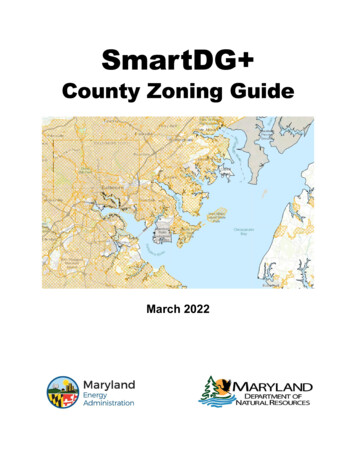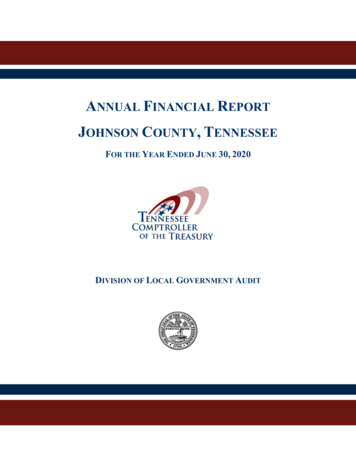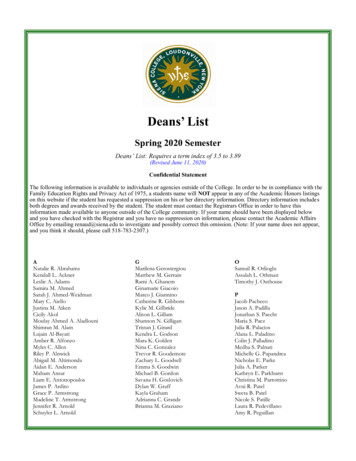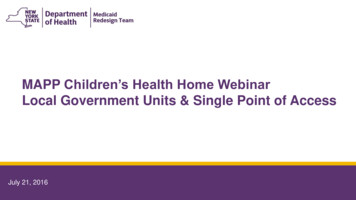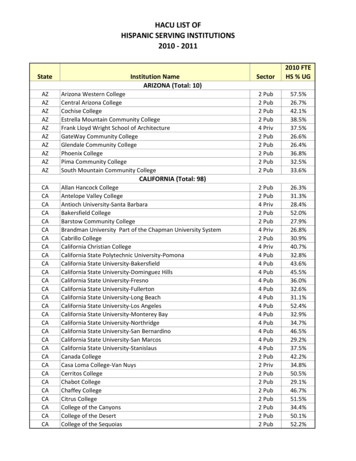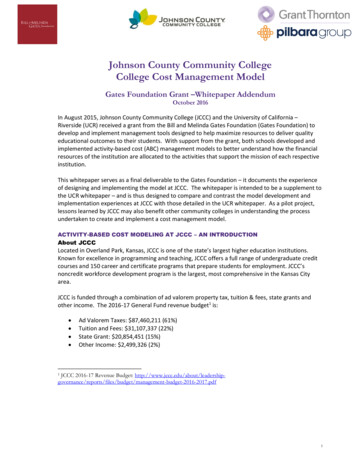
Transcription
Johnson County Community CollegeCollege Cost Management ModelGates Foundation Grant –Whitepaper AddendumOctober 2016In August 2015, Johnson County Community College (JCCC) and the University of California –Riverside (UCR) received a grant from the Bill and Melinda Gates Foundation (Gates Foundation) todevelop and implement management tools designed to help maximize resources to deliver qualityeducational outcomes to their students. With support from the grant, both schools developed andimplemented activity-based cost (ABC) management models to better understand how the financialresources of the institution are allocated to the activities that support the mission of each respectiveinstitution.This whitepaper serves as a final deliverable to the Gates Foundation – it documents the experienceof designing and implementing the model at JCCC. The whitepaper is intended to be a supplement tothe UCR whitepaper – and is thus designed to compare and contrast the model development andimplementation experiences at JCCC with those detailed in the UCR whitepaper. As a pilot project,lessons learned by JCCC may also benefit other community colleges in understanding the processundertaken to create and implement a cost management model.ACTIVITY-BASED COST MODELING AT JCCC – AN INTRODUCTIONAbout JCCCLocated in Overland Park, Kansas, JCCC is one of the state’s largest higher education institutions.Known for excellence in programming and teaching, JCCC offers a full range of undergraduate creditcourses and 150 career and certificate programs that prepare students for employment. JCCC’snoncredit workforce development program is the largest, most comprehensive in the Kansas Cityarea.JCCC is funded through a combination of ad valorem property tax, tuition & fees, state grants andother income. The 2016-17 General Fund revenue budget1 is: Ad Valorem Taxes: 87,460,211 (61%)Tuition and Fees: 31,107,337 (22%)State Grant: 20,854,451 (15%)Other Income: 2,499,326 (2%)JCCC 2016-17 Revenue Budget: 1
JCCC’s mission is to inspire learning to transform lives and strengthen communities. In order tosupport the Johnson County community, the school has laid out an ambitious strategy to meet itsmission: Innovative, high-quality curriculumPreparation for college/universitytransferOccupational preparation andretrainingHigh enrollments and accreditationA diverse student bodyDedicated faculty and staffA beautiful, well-maintained campusSupportive student servicesPrograms for special student groups Collaborative programs with otherschoolsInternational educationLifelong education and hmentAffordable costsEasy enrollmentAthletics on campusPromoting economic developmentand partnerships2To meet its mission, JCCC serves a wide and varied student body – serving the needs of the entireJohnson County community. Fall 2015 credit enrollment student headcount was 19,091 (32% full time;68% part time). 77% of the student body resides in Johnson County, with 16% being from other Kansascounties, and the remaining 7% from out of state. To meet the educational needs of the entirecommunity (most notably because not every student can take courses taught in the conventionalclassroom), JCCC also offers online classes, self-paced study, courses taught by arrangement, weekendclasses, classes at local high schools, late-start classes, accelerated classes and credit through priorlearning assessment. Supporting this student body presents unique management challenges, two ofwhich were significant to the College’s cost management model development and implementationprocess:1) how to evaluate and manage performance between “traditional” for-credit academic learningand non-credit, certificate based, training; and2) understanding the implications (particularly to facilities management) of increased onlineenrollment.Further in support of its mission, the school is currently engaged in a 3-year strategic plan. Goal 4 of thisplan is to commit to the efficient use of resources to strengthen quality of offerings.3 This goal consistsof 3 tasks:1) reduce administrative costs as a percentage of total expenditures through streamlining businessprocesses, service area reviews and reallocation of resources from administrative functionstoward direct student success activities;2) improve facility utilization; andFulfilling JCCC’s Mission: -mission.htmlStrategic Planning at JCCC: http://www.jccc.edu/about/leadership- governance/ administration/ president/strategic-planning/ goals.html232
3) revamp the budget process to align with the strategic goals.In addition, the College’s strategic plan focused on fully implementing academic program review toensure curricular offerings maintain high quality and align with community needs. One element of theformer program review cycle involved cost data through traditional expenditure reports of directacademic departmental costs. Implementing a cost management model using ABC principles provides adifferent lens through which decision-makers can identify opportunities to evaluate costs and revenuesto achieve the goals set forth in the strategic plan.JCCC Model GoalsThe goal of the Gates Foundation higher education cost management pilot project is to betterunderstand instructional resources and to build a model to share with other universities, communitycolleges and educational institutions by implementing an Academic Cost Structure and PerformanceManagement system.4 JCCC participated in the pilot project because the institution was interested inleveraging new and improved data to inform advancedmanagement analytics and decision-making. The model wasdeveloped to provide insight into the margin andperformance of the institution not previously available. Withan accurate understanding of the activities and cost base“To summarize, and thiswhich make up operations, management can adjust andis an essential point, themanage those operations with a fuller understanding of howgoalof ABC is not simplyvarious aspects of the institution’s operations impact marginto reduce costs, which weand performance. Adding revenue to the model allows costalready know how to do.dimensions to be compared to the amount of fundingRather, acknowledgingreceived, providing for a comprehensive analysis of margins.that all of our decisions areThe model was also developed in such a way to provide abasis for analyzing class sizes and durations, and determiningcapacity utilization of current buildings and their impact onthe margin and performance of the institution.Understanding the institution’s cost base, margin andperformance through a college cost management model putsJCCC in a strong position to conduct “what if” analysis andpredictive modeling. A select list of management informationJCCC leadership was interested to see as model outputincluded: made under costconstraint, the goal is tohave information aboutcosts that allows us tomaximize the quality weget for any level ofspending.”Massy, 2016Program margin: The allocation of overhead costs to particular departments and programs,giving more precise information as to the relative operating margins for programs at JCCC.Facility utilization: To meet community demand, JCCC has greatly expanded the amount ofonline courses offered, with nearly 20% of its credit offerings now delivered online. Because themanagement model captures facility, activity and timetabling data, it provides information tohelp understand how classrooms and other building space is utilized across the campus.Normalize credit and continuing education courses: As a community college serving alleducational needs of the community, JCCC has a strong continuing education certificate-basedGates Foundation How We Work Grants Database: nks/Grants-Database/Grants/2015/08/OPP113564743
program. Because the continuing education program is managed (and “success” is defined)differently from “traditional” for-credit teaching, it is challenging to evaluate and assignoverhead consistently to these two parts of the college. The model is designed to normalize thisdata through activities, and assign overhead cost across the entire institution.Support existing reporting: As a management thought leader among community colleges, JCCCparticipates in a number of initiatives (including the National Community College Cost &Productivity Project (NCCCPP) and National Higher Education Benchmarking Institute) designedto analyze and implement best practices. The model is designed in such a way to capture datathat can be reported to these institutions.Support the new Administrative and Service area review process: The allocation of overheadcosts provides more information as to the relative operating margins for administrative andservices area reviews.As more schools implement and adopt these cost management models, JCCC also seeks to leverage datafrom similar institutions to perform benchmarking analysis and develop and share best practices.MAKING ABC A SUCCESSFUL DECISION MAKING TOOL FOR JCCC MANAGEMENTSetting ABC Management Modeling Up for Success - Key Considerations at JCCCAs described above, designing and implementing a cost management model is a complex task. Manyconsiderations need to be made by all relevant stakeholders before the project is initiated to helpensure the model is properly constructed, and the subsequent reporting capabilities meet the needs ofinstitution management. In addition to theKey Value #1:considerations above, JCCC identified several otherThe Ethic of Efficiencyitems that helped to prepare for and implement asuccessful cost management model (or, conversely,When public universities are so short ofthings they “wished they knew” when they started).funding, there is an ethical imperativeKey specific considerations at JCCC included:to ensure that every dollar spent isallocated in such a way as to best serve1) Define model goals: There is not a “one-sizetheir institutional missions. Harryfits-all” solution to developing a cost model.Brighouse at the University ofRather, it is a model designed to uncoverWisconsin has termed this imperativeactivity-based data that was not previouslythe “ethic of efficiency”. Rather thanavailable. Thus, it is paramount to understandcharacterizing efficiency as somethingwhat information an institution wants to getthat undermines a university’s valuesand mission, the ethic of efficiencyout of the model, so that the model is designedmaintains that if leadership is able toand implemented in such a way that it supportsfree up even one dollar to invest in athe reporting outputs needed to make keyhigh priority mission, there is an ethicalmanagement decisions.obligation to do so.4
2) Academic leadership is key: At any higher education institution, teaching is a critical activity indelivering the school’s mission, and academics serve as key actors in that activity. Further,academics have key insights into how courses are delivered, which is fundamental to asuccessful model build. Thus, it is important toinvolve and receive regular input from theKey Value #2:academic community in the model’sMaking Informed Decisionsdevelopment.Academic leaders must continually3) Normalization of data: A feature of an ABCassess their available and finitemodel implementation is that it takes data fromresources in order to somehowacross the enterprise and normalizes it. Often,determine the most effectiveparticular data sets at a school are managed incombination of courses and class sizes.“silos” (that is, they are developed and used forUltimately, the greater question is notone purpose, and thus never directly linked orwhat courses to teach or who shouldcompared to other data sets at the school).instruct, but rather whether theInconsistencies can arise in how similar dataacademic leaders have the necessarypoints are managed in different data sets. Thedata to adequately consider thecost management model development processoptimization of limited resources.forces data sets to be compared and directlylinked to one another. An ancillary benefit of the JCCC implementation is that it gives insightinto these inconsistencies, and enabled the school to better standardize its data dictionary.4) Address concerns: At the outset of a cost management model project, it is important to discusswhat the model is, and what it is not. Key to stakeholder buy-in at JCCC is to articulate that themodel is designed to better understand costs and program margins. It is equally important toemphasize that the model is not a cost cutting tool – the intent is not to identifyactivities/classes/etc. that are “expensive”– a high-cost program may be operating efficiently, bemeeting community needs, and have strong student outcomes– indicating the school shouldreplicate those activities and behaviors.UNDERSTANDING AND USING ABC MANAGEMENT MODEL DATA AT JCCCWhat Information Can an ABC Management Model Provide?In order to precisely and accurately allocate costs to activities, products and services across theinstitution, the JCCC cost management model was designed to drill down to the cost of individualcourses in each department. Thus, the model effectively stores all information at a per-course level.Each course entry contains a number of data fields that include the course’s calculated revenue,expense, and margin, as well as information regarding type of class, class size, delivery mode, type ofstudent enrolled, credit hours, etc.By having the entire cost structure of the college allocated down to a course-by-course level (or theequivalent non-teaching output), there is significant ability to aggregate the data through differentlenses—such as department, division, course level, course delivery type, etc. In this structure, revenueand expenses are captured on an individual course section level, but can be aggregated up to allofferings of that course, total courses in the department, total courses in the division, total cost withinthe College, and total teaching cost for the College. The model also includes non-teaching outputs likepublic service (e.g., the College’s Nerman Museum of Contemporary Art or its Carlsen Performing ArtsCenter) and auxiliary and self-supporting outputs (e.g. dining, vending, bookstore, cafes, etc.)5
How Model Data is used at JCCCA key driver to motivate higher education institutions to develop and implement a cost managementmodel is to uncover insight into the margin and performance of the institution not previously available.Because the data is stored at the per-course level, with ability to aggregate to different levels, JCCC isable to define and design a number of reports to support management decisions. In the short time JCCCmanagement has used the model, they have already identified data that provides better insight intohow activities are consuming financial resources – identifying activities and outcomes that require moreinsight and analysis, helping to drive more informed management decisions (it is important to note thatthese are immediate uses, and that JCCC is considering numerous other analyses as the model and itsmanagement becomes more mature). Some examples include: New insights into program margin: Previously, class-level margin analysis at JCCC consisted ofanalyzing the direct tuition revenue and direct costs associated with delivering a particular class.A key feature of an ABC model is that it increases transparency by providing a means to applyoverhead costs (in addition to direct costs) to individual courses through the activities thatsupport each course. Applying the overhead costs, and more precisely applying direct costs,greatly increases both the revenue and cost associated with a course – and can also significantlyalter the margin between revenue and cost. This uncovers new insights into the operatingmargin of JCCC courses and programs.Figure 1 below illustrates the difference between the College’s previous program review model(analyzing revenue, expense and operating margin), compared to analysis using the ABC model.The College formerly applied only direct tuition dollars and formula-based State appropriationsto program revenue. A driver within the ABC model directs local ad valorem property taxes toprogram enrollments for students who reside within Johnson County. At the same time,overhead costs related to support activities (e.g., facilities and maintenance cost, administrativesupport costs, etc.) are applied to direct program expenses. One can see that this analysischanges the view of program revenues, expenses and program margin, moving this programfrom one having a significant loss, to one with a positive margin.6
Figure 1. Program-level margin analysisIn addition to the insight for program-level revenue/expense/margin information, the detail built intothe cost management model also provides information on other specific measures, includinginstructional methods and course-level student enrollment and margin information. The first graph inFigure 2 below shows the margin for all courses by each course instruction method (face-to-face, online,hybrid, etc.) within a particular program. The second graph illustrates the relationship between studentenrollment and margin for each course offered within a program. In this example, each blue dot is aspecific course (metadata on the course can be seen in the reporting software by clicking each dot). Thedata in the model provides JCCC decision makers with more information related to each course at theCollege.Figure 2. Additional program-level analysis support7
New insights into facility utilization: An important management consideration for JCCC ismoving from “traditional” face-to-face learning to more online class offerings – meeting theneeds of their diverse, community-based student body. JCCC is in the process of developing afacilities master plan, and wants to understand how space is utilized as they move to moreonline course offerings. At the time of the cost management model implementation, the schoolhad limited facilities data. Combining the needs of a facility master planning exercise and theABC model, JCCC stakeholders worked to capture facilities data in a way that would support themodel and JCCC’s future facility planning needs. An end result is a customized Room Utilizationreport, which helps management analyze room utilization (Figure 3 below).Figure 3. New insights into facility utilization Ability to compare course delivery methods: The cost management model uncovered newinsights into the margin of offering a course “face-to-face” versus online. In Figure 4 below, therevenue and gross margin for face-to-face for Accounting I is higher than online (driven by morestudents), but the percent margin is greater for Accounting I online (driven by very low expensedue to no facility costs associated with online classes). Further, applying a per-student full-timeequivalent (FTE) revenue, cost and margin amount gives insight into the relative cost of deliverytype. Combining this information with the facility utilization information (above) will enableJCCC to make informed decisions about the impact of transitioning to online delivery.8
Figure 4. Comparison of course delivery methods Support existing reports: As a cost and performance management thought leader, JCCCparticipates in a number of projects (including the Benchmarking Institute and NCCCPP) thatcollect college-level cost and performance data. The cost management model is designed insuch a way to incorporate data elements that provide reporting information that can besubmitted in support of these projects. For instance, inclusion of key attributes such as theClassification of Instructional Programs (CIP) makes it possible to calculate and report data byCIP, thereby supporting existing reporting requirements. Figure 5 below provides JCCC withdata information on academic resources for the Fall 2014 semester (expressed in terms ofannual FTE) by CIP code. This data can used by JCCC for NCCCPP reporting.Figure 5. Existing CIP reporting support9
Understand impact of different allocation scenarios for ad-valorem tax revenue: JCCC receivesapproximately 87 million in annual property tax revenue from Johnson County. In the College’sprior program review cost and revenue analysis, only direct course tuition and formula-basedstate of Kansas appropriations were allocated to credit courses. As the ABC model wasdeveloped, it was determined that most ad-valorem tax revenue would be driven to creditclasses based on Johnson County resident student enrollment, as it was assumed that thecommunity benefits from the availability and administration of these courses. However, JCCCmanagement is interested in understanding the implications of distributing some of this localproperty tax revenue to other College outputs that are assumed to benefit the community –including community service and continuing education expenses in the JCCC general fund. Toaddress this need, JCCC developed different report scenarios in which different proportions ofthis tax revenue is distributed to different products and services of the College.MODEL IMPLEMENTATION AT JCCCThe JCCC cost management model pilot project commenced in December 2015. The initial design andimplementation project consisted on the following phases:1) Vendor selection and cost management model setup2) Cost model development3) Data validation (ongoing)4) Cost Management Model data/report roll-out and adoption across campus (ongoing)JCCC is currently engaged in the data validation and roll-out and adoption phases – reviewing the costmodel outputs to ensure they meet management needs, and sharing the analysis and benefits acrossthe campus. JCCC’s cost management model implementation pilot required broad engagement ofcampus stakeholders, as well as collaborative partnerships with numerous external entities – mostnotably the Gates Foundation, Grant Thornton LLP and the Pilbara Group.This section provides an understanding of the level of effort needed to develop and implement a highereducation cost management model, defines the model development process at JCCC and UCR, anddiscusses observations from JCCC’s project experience.Level of EffortThe table below summarizes the timeline and costs (software, external consulting costs and internalstaff time) for each phase of the project. It is important to note in defining level of effort that eachschool is different, and there are key drivers that determine the size, scope and complexity of an ABChigher education management model. The most significant drivers that impact level of effort are schoolsize, complexity of the data sets, and the degree to which the different data sets are comparable to eachother. The assessment conducted during the Scoping Study (described below) will give a more preciseunderstanding of the LOE required to conduct implementation activities at a particular campus.10
JCCC Implementation SummaryTimelinePhase IVendor Selectionand Model SetupPhase IIStrategic CostAllocationPhase IIIData Validationand AnalysisPhase IVData/Report Socializationand Adoption3 months3 months6 months1 year(est. next 12 months)Software Cost (per 12month license)5:External Consultants forModel Implementation:External Consultants forFaculty Survey:Internal Staff: 24,000 272,000Annual Update 50,000 35,000 50,000 or 1 FTEfor 6 monthsTable 1. Level of effort estimate 75,000 or 1.5 FTE for 6 months 100,000 for 1.0 FTE for 1yearJCCC Model Development ProcessGrant Thornton LLP and the Pilbara Group were retained by both JCCC and UCR to develop the costmanagement model at each campus. In the spirit of the overall grant from the Gates Foundation, theimplementation teams worked in close coordination to ensure models were designed using a similarconstruct, and thus were comparable. Fundamentally, the implementation focused on the five samekey milestones: 1) conduct scoping study, 2) create GL and human resources (HR) modules, 3) createprogram, course and facilities modules, 4) present balanced and reconcilable first pass model, and 5)present balanced and reconcilable second pass (final) model. These 5 milestones are described below:Milestone 1.Conduct ScopingStudyMilestone 2:Create GL and HRModulesMilestone 3:Create Program,Course andFacilities ModulesMilestone 4:Balanced andReconcilable FirstPass ModelMilestone 5:Balanced andReconcilableSecond Pass(Final) ModelFigure 6. ABC model development process1) Scoping study: The integration of new technologies into existing operations is a complex task,especially since this usually involves integrating isolated systems running independently of oneanother. The scoping study milestone is designed to assess the range of data available and theorganizational issues requiring review. The high-level requirements identified during thescoping study were performed in conjunction with the personnel responsible for managing thecost model. At the end of the scoping study, JCCC was provided with a summary analysis and acomprehensive report on the: 1) suitability of the institution’s data, 2) data limitations, 3)linkages between source system data, 4) expected outcome refinements, and 5) projectedtimeframe and cost changes.2) GL and HR modules: This milestone entails loading all GL and HR data into the GL and HRmodules of the model. This process includes connecting the identified structure and interrelated data coming from each of the data sources. Connecting the data based on unique fieldscreates consistency in the way the model treats data and develops a model environment withreliable business rules.JCCC acquired a limited version of the ACE software called ACE-lite. This version limits the number of users anddoes not utilize a standalone server to hold the institution’s model(s).511
3) Program, Course and Facilities modules: This milestone entails loading all remaining data intothe model. The objective of milestone three is to create the model’s activity module anddevelop the Program, Course, and Facilities modules by integrating student data,timetable/scheduling data, and facilities/asset data. As with the GL and HR modules, theidentified structure and inter-related data originating from each data source requires a definedstructure to ensure consistent treatment.4) Balanced and reconcilable first pass model: The goal of this milestone is to finalize all modeldrivers and assignments to ensure that all revenue and cost used in the model are assigned inthe most appropriate way. Additional business rules were determined to account for additionalrequirements and model calculations were integrated so that all value items flow through themodel appropriately.5) Balanced and reconcilable second pass (final) model: This final milestone incorporated furtherrefinements and allocations to the model based on feedback received from the JCCC costmanagement team. At this point, all reporting cubes were finalized and reports were developedso as to assist JCCC personnel with model analysis and for distribution to key stakeholders. Afterall model changes were incorporated, a final review of the model was conducted on-site at JCCC.At this point JCCC began to internally review the model to verify no further model refinementswere required.Observations and Challenges – Comparing Implementations at JCCC and UCRJCCC and UCR serve as good baselines for the Gates Foundation higher education cost managementmodel pilot project because they serve two different academic constituencies, the public 4-yearresearch institution and a 2-year community college. There are key similarities and differences betweenhow these two types of higher education institutions operate. This leads to some defined modelactivities being the same between the two types (e.g., teaching), while others are different (e.g.,research). Because a cost management model maps financial resources to the activities performed insupport of the mission of an institution, it is important to note the similarities that can be leveraged byother institutions, as well as the differences - which can be analyzed and evaluated by other institutionsseeking to design and implement a successful cost management model. This section identifiesobservations and challenges identified during the JCCC cost management model pilot project, and,provides discussion as to whether they were similar or different to experiences during the UCR project.Observations and Challenges – SimilaritiesA fundamental goal of any higher education institution is to educate students in order to enable them tobe productive contributors to society (which can mean many different things to many different people).Thus, there are key fundamentals to developing a higher education cost management model that werefound to be similar at JCCC and UCR, and are likely to be similar at most higher education institutions.Key similarities identified during the respective model builds included: Complexity of tracking revenue: A common challenge in developing higher education costmanagement models is that expenses are assigned to unique Fund-Organization-AccountProgram-Activity-Location (FOAPAL) codes, while a majority of revenue is generally centrallyassigned to one or a few codes (e.g., tuition revenue, grant revenue, etc.). It is thus difficult toaccurately assign revenue as precisely as cost to the correct structures and objects in the model;a set of assumptions and revenue allocation drivers must be developed to assign revenue in themodel. While the need to establish revenue allocation methodologies is something mostcolleges and universities will have to address, the specific methodologies and business rules12
used may vary greatly from institution to institution based on numerous factors. Consi
Johnson County community. Fall 2015 credit enrollment student headcount was 19,091 (32% full time; 68% part time). 77% of the student body resides in Johnson County, with 16% being from other Kansas counties, and the remaining 7% from out of state. To meet the educational needs of the entire

